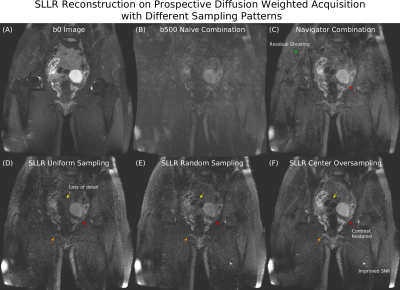Philip Kenneth Lee1,2, Yuxin Hu1,2, Catherine Judith Moran2, Bruce Lewis Daniel2, and Brian Andrew Hargreaves1,2,3
1Electrical Engineering, Stanford University, Stanford, CA, United States, 2Radiology, Stanford University, Stanford, CA, United States, 3Biomedical Engineering, Stanford University, Stanford, CA, United States
1Electrical Engineering, Stanford University, Stanford, CA, United States, 2Radiology, Stanford University, Stanford, CA, United States, 3Biomedical Engineering, Stanford University, Stanford, CA, United States
Cartesian Fast Spin
Echo can improve distortionless diffusion weighted imaging with multi-shot sampling
patterns that complement low-rank compressed sensing reconstructions.

Figure 5: (A) T2-weighted b0 image. (B) Naive combination of 12-shot data has severe multi-shot
ghosting resulting in signal dropout. (C) Navigator shot combination has some residual ghosting (green). (D)
SLLR reconstruction of uniformly sampled b500 data has loss of detail (yellow,
orange), and reduced organ contrast (red). (E) Random sampling improves detail
(yellow, orange). (F) Center oversampling further enhances detail (yellow,
orange), restores organ contrast, matching the navigator combination (red), and
improves SNR (white).

Figure
1: Random sampling patterns were generated by dividing
k-space into $$$ETL$$$ segments, represented by different colours. Each sample is
randomly assigned to a shot. K-space is fully covered when shots are combined.
For center oversampling, the center two ky lines were added to the beginning of
a randomly generated shot. A low-resolution phase navigator was explicitly acquired
with uniformly sampled data because the shot undersampling factor is too high
for parallel imaging to recover phase maps.